How dinosaurs died out - the last heavy tanks (part of 4)
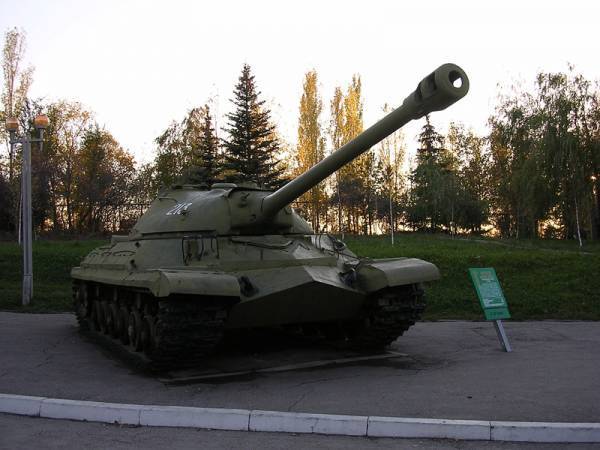
Heavy tank T-10 - the last in the list, but not by value!
The initial impetus for the development of a new heavy tank served the fact that by the end of the 40s of the last century, the Soviet Army was armed with three types of tanks of this class - IS-2M, IS-3 and IS-4, but none of them met all the requirements of the military and all of them have already been discontinued. Therefore, by the end of 1948, the terms of reference for the design of a heavy tank had been worked out in GBTU, and the design bureau of the Chelyabinsk plant was chosen as the developer, and J. Kotin was appointed chief designer. The “Object 730” was supposed to be equipped with an IS-4 tank-type chassis, but for some reason the form of the hull was borrowed from the IS-3. The upper limit of the mass of the equipped tank was determined at 50 tons.
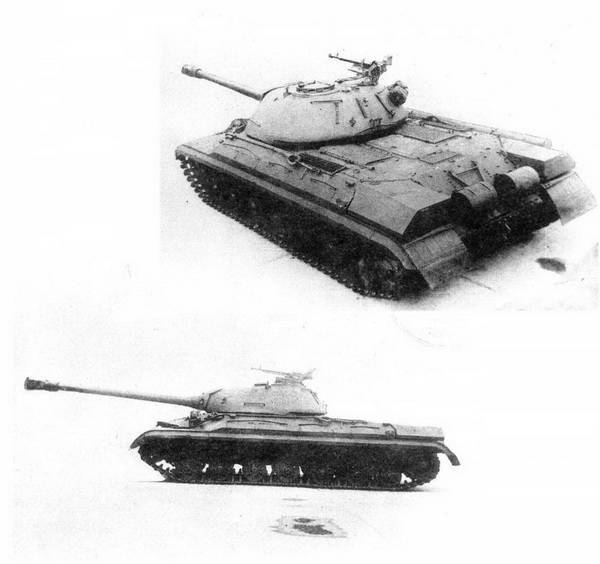
Preliminary design was completed by April 1949 of the year, in May, having built a full-size wooden layout. The tank had seven road wheels on board, and a characteristic hull with a “pike nose” nose section inherited from the EC-3. The construction of an experimental copy of the “730 Object”, which was supposed to be called EC-5, began immediately. Successfully passing the factory tests, the prototype became the basis for the installation batch in 10 tanks, which entered the tests in the same 1949 year. The two stages were successfully completed, and in April-May 1950, the state testing stage at the NIBT test site in Kubinka began. In general, the test commission evaluated the tank positively, recommending it for mass production, after completing the elimination of the identified deficiencies (mainly for logistics and logistics). Additionally, in the summer, tests for a guarantee resource were conducted, and in the fall, military tests followed. However, the volume of improvements was great, the tank was constantly being finalized and changed. The result of the introduction of all the corrections was that the tank was so different from the prototype that the name was successively changed to EC-6, then EC-8, EC-9 and finally EC-10 (some sources indicate that the tank initially had an EC-8 index). The changes required verification, in connection with which the tank passed all new factory, control and state tests. Crumpled sad experience of adopting not fully finished cars, and the customer and the developer carefully checked all the implemented decisions and changes. Even with the escalation of the Cold War and the conflict in Korea (which could easily turn the cold phase into a very hot - nuclear phase) every month spent on meticulous tests, saved millions of rubles in the future, thousands of man-hours on repairs and possibly saved the lives of crews . As a result, the debugging was delayed until December 1952 of the year, and mass production was scheduled for the spring of the 1953. But in connection with the death of I.V., Stalin and the subsequent permutations of leaders of various ranks, the adoption of the Soviet Army was delayed - the first production tanks left the factory only towards the end of the year. The name of the tank at the same time changed from EC-10, to a modest T-10.
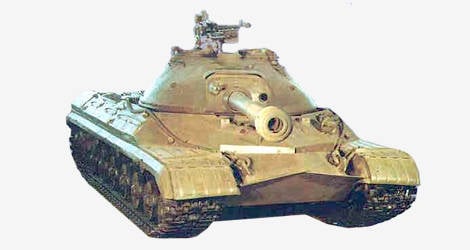
Already after the start of mass production, in the 1954, the version of the D-25Т instrument, equipped with the PUUOT-1 "Hurricane", was developed and brought to life in the vertical plane. At the Leningrad Kirov Plant, a prototype model “267 sp.1” object was built for testing this gun, and the tank was additionally equipped with a new TPS-1 gyro-stabilized sight, “upon completion of the tests, the tank was put into service in the autumn of 1955, under the designation T-10А (“ 731 Object ” ). The new installation of the gun and its drives required a slight change in the shape of the tower in the vicinity of the embrasure and the mask of the gun, and the gun barrel was additionally supplied with an ejection device to reduce the gas content of the fighting compartment. Upgrades were the mechanism of vertical guidance and galvanic device shutter device (before that, the descent was only mechanical). In parallel with 267 1 Object, 267 2 1957 Object was tested, with a two-plane stabilizer, but this variant was brought later, and its adoption took place in 10 year under the designation T-2B. In addition to the PUOT-2 “Thunder”, the tank is equipped with a T29C-14-XNUMX sight, otherwise no changes were made. In this case, it is extremely important to note that new modifications of the tank appeared thanks to the development of new, more advanced types of weapons and equipment, and not to “pull up” it to the customer’s initial tactical and technical requirements, as happened with previous heavy tanks - the rate for long-term, but thorough tests before adopting fully justified themselves.
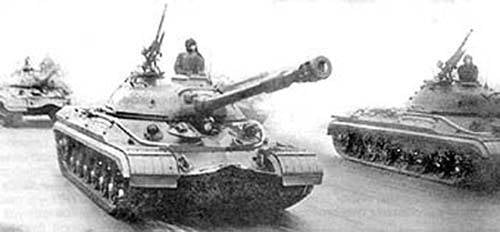

At this time, the Perm Plant Design Bureau No.172 created a new 122mm M-62-T2 (2X17) cannon with a high initial velocity of an armor-piercing projectile - 950 m / s. Equipped with a two-plane stabilizer 2E12 "Downpour", the gun was tested from the 1955 of the year on various experimental machines. The next stage of modernization of the tank did not stop only on the replacement of the main armament, large-caliber machine guns of DShKM 12,7mm caliber were replaced with 14,5mm KPVT (both paired and anti-aircraft), ammunition reduced to 744 cartridges, with a constant number of projectiles (30 pieces). The tank also received a full set of night-vision devices — the commanding TKN-1T, the TPR-1-29-14 (Luna II) gunner, and the TVN-2T driver-mechanic, who were equipped with infra-red searchlights. The shape of the tower changed again and, additionally, a spare parts box appeared in its stern. Engine replaced with B-12-6, forced to HP 750
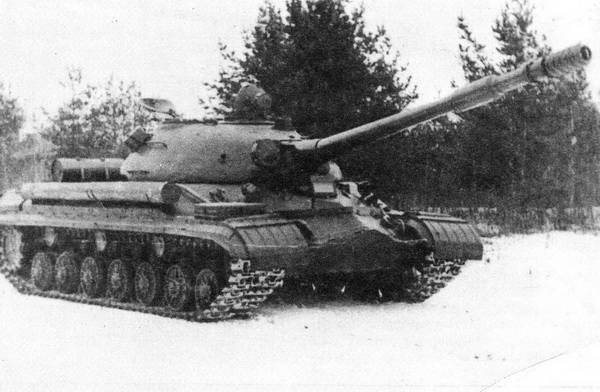
Created on the basis of the experienced "272 Object" in mass production, the tank was named T-10M, becoming the last modification of the family. But in the course of production, various changes were made, for example, the 8 speed gearbox replaced the 6 speed gear, in the 1963 year OPT was added to overcome the fords to a depth of 5 meters, and with the 1967, ammunition and cumulative shells are introduced into the ammunition. The tank’s serial production was discontinued in the 1966 year, the author could not find the exact data on the number of cars produced - Western assessments of the 8000 produced tanks do not inspire confidence, domestic authors indicate “more than 2500”, which is most likely an underestimate. In any case, the T-10 tank is without a doubt the most massive post-war heavy tank, and possibly the most massive heavy tank in stories tank building in the world. High performance and timely upgrades allowed him to be in the 40 unit for years - the order to remove the weapon was given only in 1993 year! The tank was not exported to other ATS countries, and did not participate in hostilities (except for the “Danube” operation to bring the Warsaw Pact troops into Czechoslovakia, in 1968, year).
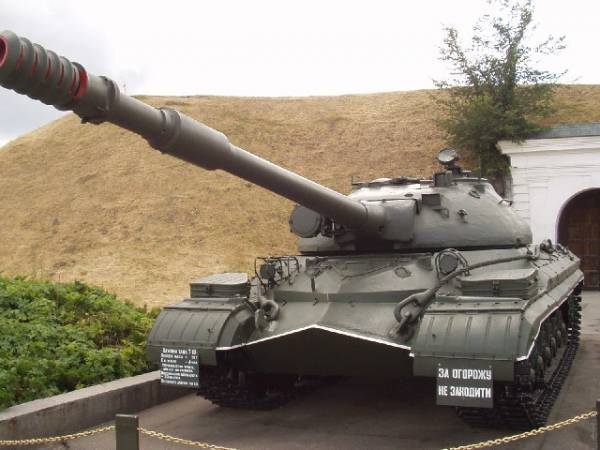
The T-10 tank became the evolutionary peak of the Soviet concept of a heavy tank - a compact and relatively light one, designed primarily to crack powerful defenses (most of them were in service with GSVG), while the task of fighting tanks was relegated to the third plan. The armor provided sufficient protection against the armor-piercing shells available at the beginning of the 50-s, but the rapid development in the 50-60-s of the last century of cumulative projectiles and missiles negated the advantages of heavy tanks over medium-sized ones, to counter them they required fundamentally different approaches. Like many other types of vehicles born during the transition period, the T-10 received a very mixed assessment of both contemporaries and historians of armored vehicles. On the one hand, it is impossible to note the high security, mobility and firepower of the tank, exceeding the average T-54 / 55 , but the appearance of the T-62 with a smooth-bore 115mm gun and not much inferior in security narrowed the gap (which increased again with the adoption of the T-10М). At the same time, it became clear that a fundamentally new tank was required, a single tank — the main battle tank, which would combine the mobility, security and armament of heavy and medium ones, surpassing them all. Even after all upgrades, the T-10 could not meet the new requirements, and as it arrived, the T-64 and T-72 were taken out for long-term storage pending disposal.
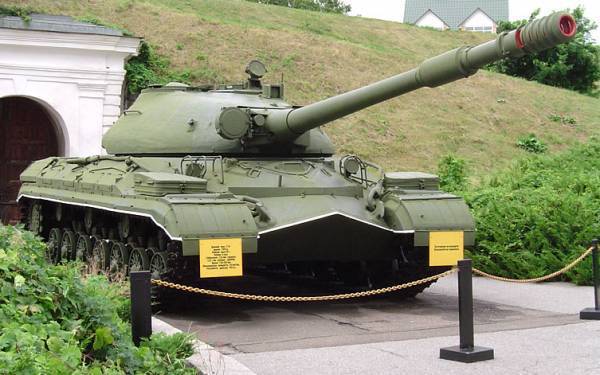
And in conclusion, I would like to point out such a rare role of the last heavy tank of the USSR as ... the firing part of an armored train! Yes, in the USSR there were armored trains after the Great Patriotic War, and the T-10 was used either in the form of tanks proper installed on special railway platforms (which could leave if necessary), or only the towers from them.
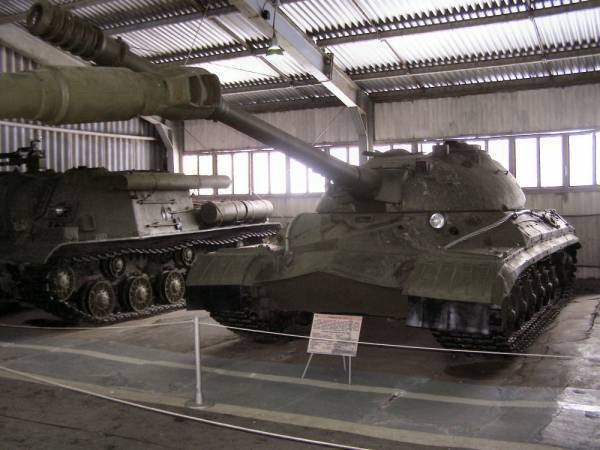
Technical description of T-10, 10А, 10Б and 10М tanks.
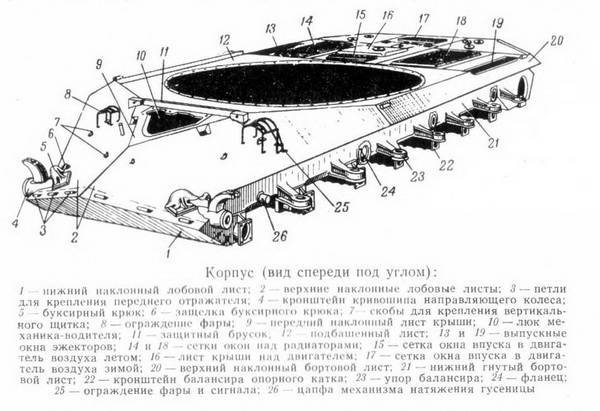
The tank is arranged according to the classical scheme, with the location in the stern of the engine compartment, the forward placement of the control compartment and the fighting compartment between them. The tank body is assembled from rolled armor plates (flat, bent and stamped), the tower is made as a single casting, with a welded sheet roof armor in the aft, in which there is a commander's cupola and landing loader hatch. The bow of the hull "crooked" is made similar to the tank EC-3 - from three plates of armor with large angles of inclination, while the upper part consists of two plates (connected along the middle of the bow of the tank) with a significant deviation from the longitudinal axis of the tank. The fourth plate, installed with a very large slope, is the roof of the control compartment and in it a sliding hatch is cut in to fit a driver who is triangular in shape.
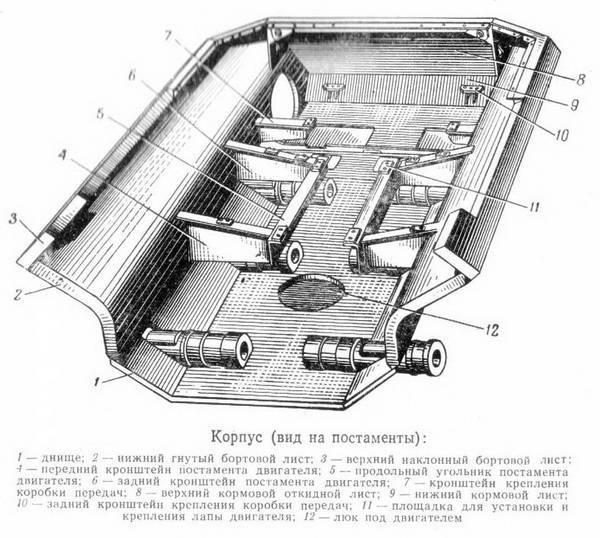
The upper part of the side has a large slope, is a flat armor detail, while the lower part of the side is made in the form of a bent plate with a reverse slope in the upper part. The bottom of the tank is stamped, trough-shaped (this allows a slight reduction in the height of the side armor below, in the least affected part, thereby reducing the mass), flat in the transmission area. Aft armor plate is made folding, for easy access to the transmission units. The chassis has an independent torsion suspension and consists of seven supporting and three supporting rollers. During the tests, a beam torsion was chosen - consisting of seven rods, instead of a single rod. This is caused by the short length of the torsions, which are installed coaxially for the right and left sides, while there is a small space between them along the tank axis (i.e., the length of each is less than half the body width, while usually the torsions have a length equal to the body width, this was established with the shift necessary for their placement, in pairs). The first, second and seventh balancers are equipped with hydraulic shock absorbers.
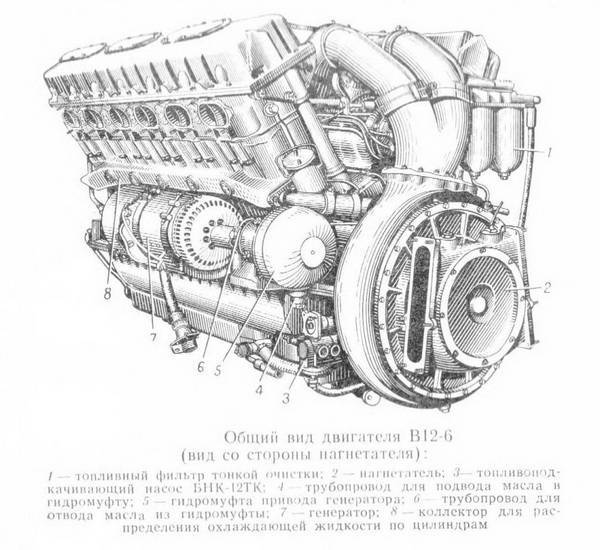
Twelve-cylinder, four-stroke V-type engine B-12-5 with horsepower 700 was a further development of the B-2, but had a very large number of differences, primarily allocated drive centrifugal supercharger. The B-12-6, which replaced it, was finalized, and forced to 750 hp. at 2100 rpm The power train was a modified planetary gear and “3K” type of gear, providing 8 forward gears and two rear gears (later 6 and 2). The main friction clutch in the classical sense was absent - the neutral transmission of the MPP ensured a mechanical shutdown of the engine. Further, the torque was fed to two-stage final drives (with simple gear and planetary gears) and to drive wheels with interchangeable 14-toothed rims.
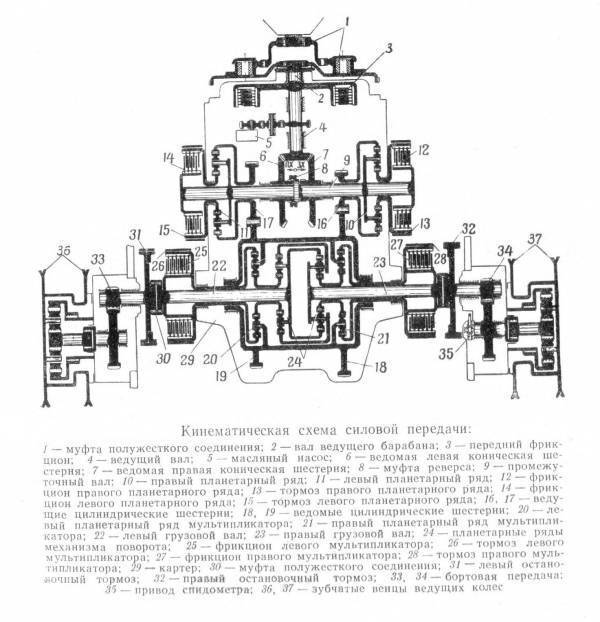
The fuel was placed in three internal and two external tanks - two feed for 185 liters (later for 270 liters) and one bow for 90 liters, and tanks on the wings in the aft with a capacity of 150 liters. All tanks are connected to a single fuel system of the tank and do not require overflow from external to internal as they are developed. The total capacity in this way is 760 (later 940) liters of fuel, which gave a range on the highway in 200..350 km. The driver has a TPV-51 surveillance device in the hatch cover, and two TPB-51 to the right and left of the hatch, and at night the TVN-2T night vision device is used. The tank commander is located to the left of the gun, behind the gunner and has a commander's turret with independent rotation of the turret, equipped with seven devices for monitoring the TNP around its perimeter, and the tank periscope of the commander TPKU-2. The gunner has at his disposal a daily periscopic gyroscopic sight with a stabilized field of view Т2С-29-14, a night sight ТПН-1-29-14 and a viewing instrument ТПБ-51. The charger has one TNP surveillance device and a collimator sight VK-4 for handling an anti-aircraft machine gun, for firing at air targets, and a PU-1 for firing at ground targets. The tank armament is located in a streamlined, cast turret and consists of X-NUMXmm D-122T rifled guns on the first series and D-25TS on T-25А and 10B tanks, or similar in caliber M-10-Т62 guns. D-2T / TC was equipped with a two-chamber muzzle brake of the active type, M-25-Т62 - with a slit reactive type. D-2TS and M-25-Т62 had an ejection device for purging the barrel after the shot. An additional armament is the twin heavy machine gun DShKM, or KPVT and a similar anti-aircraft machine gun mounted on the turret above the loader hatch. The tower is equipped with a rotating polycom.
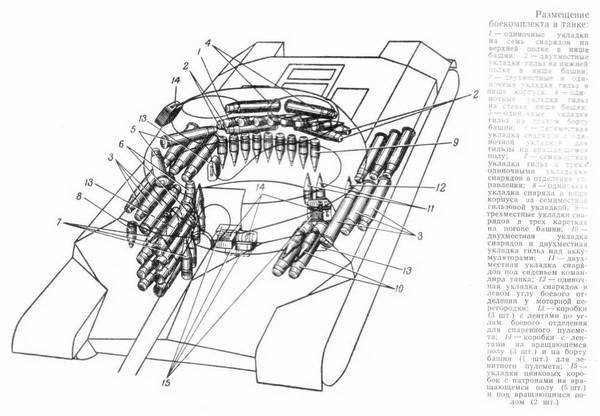
Ammunition consists of separate loading 30 shots placed in the turret and tank hull, cartridges for heavy machine guns are partially prepared for shooting and packed in boxes (two of which are mounted on machine guns), partly in zinc boxes of factory packaging. To facilitate the action of the loader, there is a mechanical rammer, on the T-10M tank, an automatic-type loader is installed, with manual feed of charges and projectiles. Using a rammer provides a firing rate of up to 3-x shots per minute, the loading mechanism allows you to fire with a shot-rate of 3-4 per minute.
For the sake of brevity, only the weapon control system of the T-10M tank, as the most advanced representative, will be considered.
When commander target designation, the tank commander, finding the target and determining the range to it, gives the command to open fire, specifying the nature of the target, the range to it, the direction and method of firing.
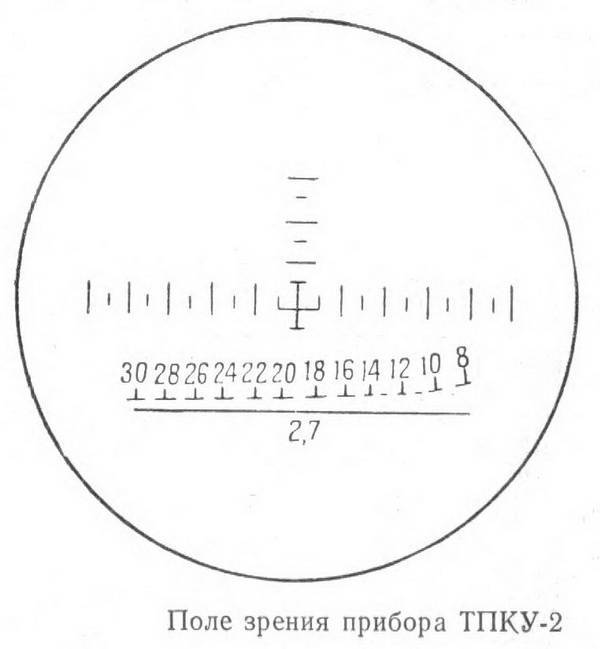
After that, having combined the TPKU-2 crosshair with a target, it warns the crew with the command “tower to the right (left)!” And presses the button located on the control stick of the device. At the same time, the control over the horizontal drive of the tower passes to the commander (as indicated by the signal light in the tower) and rotates at maximum speed until the line of sight aligns with the longitudinal axis of the tower, the commander holds the crosshair on the target and the button is pressed until the tower completely stops. After that, the control on the tower again passes to the gunner, and he finds the target in the field of view of the T2C-29 sight (or the Luna II TPN-1 “Luna II” at night) and, according to the information received from the commander, sets the range on the scale of the projectile . In the presence of lateral movement of the target, the gunner holds the central pillar mark, accompanying the target for some time.
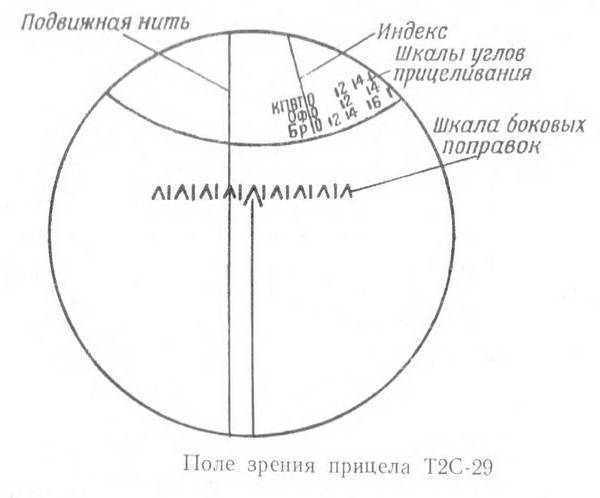
At the same time, the angular velocity of the target will be calculated and the moving vertical thread will deviate by the amount of lateral correction (based on the specified target distance), and the gunner will not use the central mark, but the square or dash through which the vertical thread passes. At this time, the loader removes the specified type of projectile from laying and puts it on the carriage loading mechanism. Holding it with his left hand, he activates the mechanism - the tray automatically goes to the loading line and the projectile is sent to the breech before the leading belt is cut in slices, after which it automatically goes back (but not to its original position). Without waiting for the automaton to finish working, the loader extracts the sleeve corresponding to the projectile (explosive fragmentation and armor-piercing projectiles are different and it is categorically unacceptable to use an improper charge for firing) and pushing it into the breech into the breech, pressing the rubber support with the bottom support — the carriage drive is activated and the sleeve is sent after which causes the tray to move back to its original position, and the instrument disengages, moving into a stabilized mode. By pressing the ready button and notifying with the command “Done!”, The charging locks the circuit, removing the firing lock.
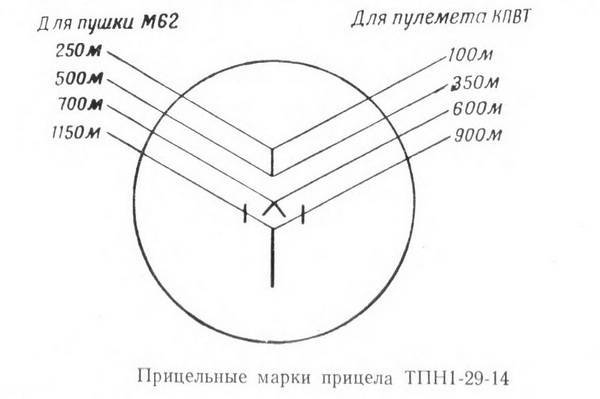
At night, when using the TPN-1-29-14 ("Moon II") sight, the gunner determines the lateral correction independently, and makes a vertical correction for the distance by shifting the aiming point according to the scale of the sight.
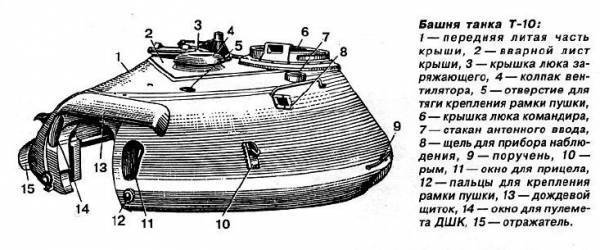
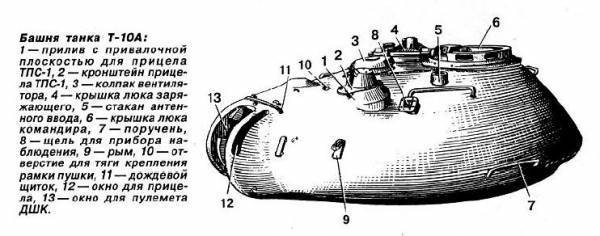
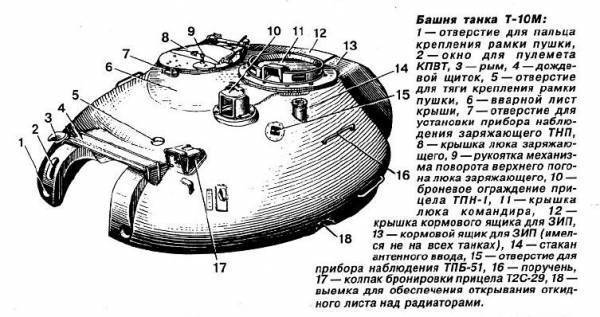
Short tactical and technical characteristics of tanks:
Crew - 4 person.
Curb weight - 50 tons
Full length - 9,715 meters (T-10, 10A and 10B) or 10,56 meters (T-10М)
Width - 3,518 meter
Height - 2,46 meter (T-10, 10A and 10B) or 2,585 meter (T-10M)
Maximum speed - 42 km / h (T-10, 10A and 10B) or 50 km / h (T-10М)
Cruising on the highway - 200-350km (for tanks before 1955 and after)
Cruising on the country road - 150-200 km (for tanks up to and after 1955 of the year)
Ground pressure - 0,77 cm2
Armament:
122mm threaded gun D-25T (D-25TS, M-62-T2), 30 ammunition of separate loading shots.
Paired 12,7mm machine gun and 12,7mm zanitnyy machine gun with a total 100 ammunition ammunition (300 in six boxes to the twin machine gun, 150 in three boxes to the anti-aircraft machine gun and 550 cartridges in zinc boxes of original packaging).
The T-10M tank is armed with a twin and anti-aircraft 14,5mm KPVT machine guns with a common 744 ammunition cartridge.
Booking:
Forehead enclosure - 120mm top and bottom
Chassis board - 80mm
Front of the tower - up to 250mm

Information